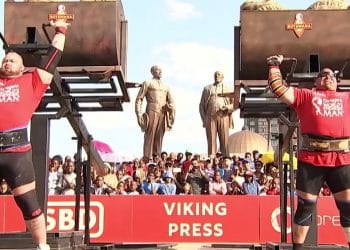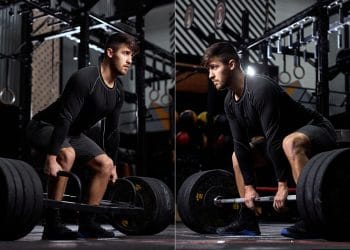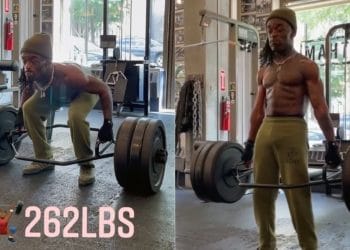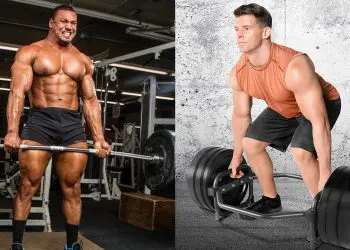The trap bar, also known as the hex bar is undoubtedly an under-utilized training tool typically used for deadlifts, shrugs, and the farmer’s walk. But you’re missing out if you think these are the only movements it’s good for.
Trap bar training can reduce spine load and it can also allow you to perform movements a bit more naturally making it that much easier for you to lift heavier which is a must for mass and strength building purposes.
Now, it doesn’t (and shouldn’t) replace conventional barbell training but it’s a tool in your box that you should pull out from time to time.
Let’s talk about the trap bar and some awesome exercises to do with it…
What Is A Trap Bar?
A trap or hex bar is a hexagonal shaped bar used for compound upper and lower body lifts. The shape of the bar allows you to stand in the middle and the handles are raised at 90 degrees to the weight loading stubs.
There’s another pair of handles that are level with the hexagon part of the bar which can be used by flipping the bar.
Level Up Your Fitness: Join our 💪 strong community in Fitness Volt Newsletter. Get daily inspiration, expert-backed workouts, nutrition tips, the latest in strength sports, and the support you need to reach your goals. Subscribe for free!
The trap bar was invented by powerlifter Al Gerard and it was named after the trapezius muscles of the upper neck.
Why Use A Trap Bar?
Besides the obvious design of the bar to assist in shrugging, the trap bar is very useful for a few different reasons.
- Less load on the spine and lower back due to the weight being closer to the center of mass which allows for a more upright spine.
- Lower body exercises using a hex bar more equally distributed the load among, the hip, ankle, and torso, making it likely more effective for improving maximum force, power, and velocity. (1)
- The neutral grip allows for a more natural body position for lifting which may alleviate bicep, forearm, and elbow strain.
- The trap bar adds more variety in training.
- Better option for those not able to perform the conventional barbell deadlift.
The trap bar is a good option whether you’re an athlete, gym-goer, or anyone who wants a change of pace.
8 Awesome Trap Bar Exercises
Here are the trap bar exercises we promised you which are much different than what you have probably seen before with the more typical variations.
Now, we skipped out on the conventional deadlifts and shrugs just so you know. But the following exercises will surely serve you well…
1. Trap Bar Bent-Over Row
The barbell row is one of the most effective back exercises you can do and according to research, it’s superior to most other similar movements due to the fact that it works the back symmetrically. (2)
But you’re definitely missing out if you haven’t tried the trap bar bent-over row because it carries similar benefits that a trap bar deadlift would. You’re closer to your center of mass and you also may alleviate some elbow and wrist stress due to the arm position. Plus, you’re likely not to bump the bar into your knees which can be annoying and/or painful!
Exercise tips:
Deadlift the bar from the ground and keep your back straight just above parallel to the ground with your knees slightly bent. Pull the bar up and slightly back so that your hands are in line with your hips.
2. Trap Bar Split Squat
The split squat is one of the best lower body exercises for hitting the quads, glutes, and hamstrings. Not to mention, it’s a great builder of unilateral (affecting one side) function which is ideal for full development and athletic movements as well.
Exercise tips:
For this movement, make sure your shins remain as vertical as possible and squat down just until your knee is a few inches above the ground. You want to make sure to keep your torso upright and face forward.
3. Trap Bar Jump Squat
This is a great variation for building explosiveness and taking advantage of the equal distribution of weight that the trap bar provides due to the position of it as mentioned previously.
Exercise tips:
Load the bar from a deadlift position so that your upper legs are about parallel to the ground and keep your back straight while looking forward. As you jump, explode upward quickly so that the ball of your foot is the last to leave the ground. Try to land in the same spot the best you can to make the set flow most effectively.
Level Up Your Fitness: Join our 💪 strong community in Fitness Volt Newsletter. Get daily inspiration, expert-backed workouts, nutrition tips, the latest in strength sports, and the support you need to reach your goals. Subscribe for free!
4. Trap Bar Elevated Pushup
Many people don’t realize that due to the fact that the trap bar has raised handles, you can use them for elevated pushups. This allows for a deeper stretch during the negative and the neutral grip makes it similar to a fly type movement in a sense.
You can perform the pushup by flipping the bar on either side. Also, you can do this variation with the bar flat on the floor or with weights which will really test your stability.
https://www.youtube.com/watch?v=Qd0bKt7kNm0&feature=emb_title
Keep your torso straight and go down low enough to feel a slight stretch in your chest. Then, as you push up, contract the muscles.
5. Pendlay Row
Pendlay Row is excellent for really loading the bar during a bent-over row. You’re pretty much touching the bar to the ground before you pick it up and perform your rows.
Tip: Explode upward using your legs when training with heavy loads to create additional overload stimulus.
6. Reeves Deadlift
Everyone needs to incorporate grip strength training because it’ll help you to have a better handle of the pulling and static strength movements. The Reeves deadlift is easier using the trap bar rather than a straight bar.
For this variation, we recommend using a 45-pound plate on each side.
What you’re doing is lifting the barbell up by gripping the actual plates and deadlifting the weight. Keep your torso as upright as you can.
7. Single-Arm Shrug
Ok, so we know the shrug is a common exercise with the trap bar. But… you may not see anyone doing this variation in your local gym. The single-arm shrug allows for a deep stretch in the traps and it’s a great isolateral movement to build overall stability while also activating the core.
To do this exercise, turn the bar on its side and pick it up as if you were carrying a suitcase. Then, shrug the weight and switch sides.
8. Trap Bar Floor Press
The floor press is an underrated movement for working the chest, triceps and improving your pressing power due to the limited range of motion which forces a stronger press above where the chest usually gets a deep stretch.
Use a rack for the floor press by lying at the end of it. The neutral grip forces the arms into a safe position for the shoulder.
9. Reeves Trap Bar Single-Leg Deadlift
Here’s a great deadlift variation that will test your balance and we all know how powerful the deadlift is for the lower and upper body. The Reeves trap bar single-leg deadlift will hit more of the hamstrings due to the forward position of the body during the exercise. The great thing is by using 45-pound plates, you can stop the movements so balance won’t be as much of an issue as with other exercises that require balance.
Maintain a straight back, keep your hips high and move your butt back during each rep. You can lift your leg up behind you or you place it on a surface for balance.
Trap Bar Training Tips
There’s no special set/rep range that you need to be doing while training with a trap bar. It would be the same for any other compound exercises where you’d utilize low, moderate, and high repetitions.
You still want to use a weight that will allow you to feel the muscle working when training with the trap bar and if one of these exercises doesn’t feel right to you, then make adjustments or do one which feels better for you instead. Sometimes using a barbell will feel better than when using a trap bar for a specific movement and depending on the individual. But the latter is a great tool for maximizing your ability to perform certain movements.
Also, you want to make sure that the weight on the bar is evenly distributed to maximize the effectiveness and safety of each exercise.
The Trap Bar Is A Great Tool For Making Gains
We hope that if you weren’t doing these exercises before that you’ll incorporate them into your regime from now on. We’re not saying these variations should replace similar movements using a straight barbell, dumbbells, etc, but it’s a great way to change things up a bit and possibly experience improvements in certain areas of your lifting.
Practice good form on your lifts and the trap bar can really work to your advantage when it comes to progressing in your muscle and strength building endeavors.








